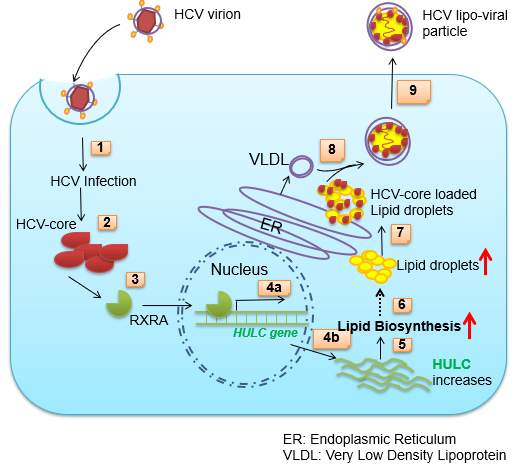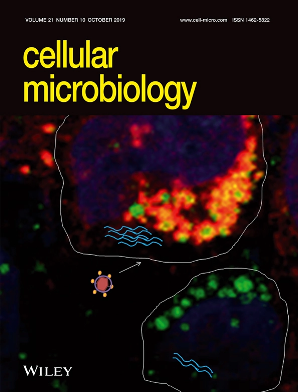
Long Non-Coding RNA HULC Helps in Hepatitis C Virus-Particle Release and Infection
Source
Indian Institute of Science, India
Highlights
- HULC is upregulated upon infection
- HULC affects HCV release and packaging
- HCV Core upregulates HULC level

Hepatitis C Virus Infection
Hepatitis C virus (HCV) causes Hepatitis. Infection by the hepatitis C virus (HCV) is characterized by a high rate of chronicity. Despite the mild, often asymptomatic course of acute infection, chronic hepatitis C frequently leads to steatosis, liver cirrhosis, and eventually hepatocellular carcinoma. The hepatitis C virus is a bloodborne virus; the most common modes of infection are through exposure to blood. This may happen through injection drug use, unsafe injection practices, unsafe health care, transfusion of unscreened blood and blood products, and sexual practices that lead to exposure to blood.
Hepatitis C virus (HCV) causes Hepatitis. Infection by the hepatitis C virus (HCV) is characterized by a high rate of chronicity. Despite the mild, often asymptomatic course of acute infection, chronic hepatitis C frequently leads to steatosis, liver cirrhosis, and eventually hepatocellular carcinoma. The hepatitis C virus is a bloodborne virus; the most common modes of infection are through exposure to blood. This may happen through injection drug use, unsafe injection practices, unsafe health care, transfusion of unscreened blood and blood products, and sexual practices that lead to exposure to blood.
Approximately 71 million people have chronic hepatitis C virus infection. A significant number of those who are chronically infected will develop cirrhosis or liver cancer. WHO estimated that in 2016, approximately 3,99,000 people died from hepatitis C, mostly from cirrhosis and hepatocellular carcinoma (primary liver cancer). Access to diagnosis and treatment for hepatitis C is low. There is currently no effective vaccine against hepatitis C; however, research in this area is ongoing.
Human liver affected by HCV. The Hepatitis C virus particle consists of a nucleocapsid, surrounded by a lipid envelope containing two viral glycoproteins, E1 and E2. HCV particles associates with cellular lipoproteins that determines both morphology and biophysical properties of the virion. Upon HCV infection many cellular pathways are affected. Cells contains different type of RNA such as mRNA, miRNA, lncRNA and so on. Long noncoding RNAs (lncRNAs) play a critical role in the regulation of many important cellular processes. However, the mechanisms by which lncRNAs regulate viral packaging and release are not well understood.
Study on Role of lncRNA in HCV Packaging and Release
Researchers at the Indian Institute of Science (IISc) at Bangalore by Dr. Geetika Sharma carried out this study to check the role of lncRNA in HCV packaging and release. The cellular lipid level plays an important role in establishing infection to virus propagation and affects hepatitis C Virus lifecycle. HULC is one of the lncRNA present only in the liver. In this work they showed that a liver abundant long non-coding RNA, HULC, is upregulated two times during HCV infection in comparison to uninfected cells. It affects the liver lipid level which supports virus life-cycle. Experiment was carried out in Huh7.5 cells (Liver carcinoma Cells).
They studied the role of HULC in HCV life cycle. They found that it was important to increase in number of lipid droplets which is needed for virus packaging in infected cells. Because HULC was affecting the lipid biogenesis, they found that the level of lipid related genes (help in lipid biogenesis) Peroxisome proliferator-activated receptor alpha (PPARA), Acyl Co-A Synthetase Long chain family member 1 (ACSL1), and 3-hydroxy-3-methylglutaryl-CoA reductase (HMGCR) mRNA levels were increased with the corresponding increase in HULC levels upon HCV infection.
Further, they quantified the level of total triglycerides (TAG) and cholesterol secreted in the medium and present in the HCV infected cells, treated with Nspsi (non-specific) or siHULC (this decreases HULC levels in cell). They observed that level of secreted TAG decreased upon HULC decrease. The total cholesterol, however, did not show any significant effect upon HULC decrease. In the HCV infected cells, newly synthesized HCV RNA is coated with HCV-core protein. This complex is then loaded onto the lipid droplets (LDs), then HCV uses the VLDL pathway for its release. TAG and cholesterol esters are the major part of LDs in the liver cells. When they decreased the HULC level by using siRNA and found that decrease in lipid droplets (LDs) associated with HCV- Core protein (one of the proteins for virus packaging). They observed that HULC knockdown (decrease its level) decrease HCV-core protein association with LDs. These study also found that HULC plays an important role in regulating the efficient release of HCV particles. This data suggests that it affects viral infectivity.
Next, they check that how HULC is upregulated in HCV infected cells. Cholesterol via RXRA increases HULC transcription hence lncRNA level increases, so they used Z-guggulsterone, a natural product which lowers the level of cholesterol. Interestingly, we found that in presence of guggulsterone the HULC level (HULC transcription) decreased significantly. It has been reported that increased activity of the RXRA (transcription factor) is mediated by HCV-core protein in HCV infected cells. We found that the binding of RXRA in promoter of HULC was significantly increased so HULC level increases. Along with these results, they also found that upon over-expression of HCV-core protein in cells, level of HULC increased.
Association of HCV core and lipid droplets is really important for the proper release of HCV particles. All results conclude that HULC is required to increase the number of lipid droplets during HCV infection and helps in further infectivity. Previous reports suggest that PPARγ and PPARα seem to be involved in viral RNA replication. HULC appears to be associated with these players of HCV RNA replication, and the substantial effect of HULC knockdown observed on the intracellular HCV RNA; so, in future it will be interesting to investigate an independent role of HULC in HCV RNA replication. HCV causes HCC so, it will be interesting to investigate, whether the increased HULC promotes cellular transformation during HCV infection because.
They first time showed the effect of any lncRNA in HCV packaging. This study opens the door for study of other lncRNA in different type of virus’s life cycle. lncRNA can affects the viral life cycle.

Journal Reference
- Sharma, G, Tripathi, SK, Das, S. lncRNA HULC facilitates efficient loading of HCV‐core protein onto lipid droplets and subsequent virus‐particle release. Cellular Microbiology. 2019; 21:e13086. https://doi.org/10.1111/cmi.13086
